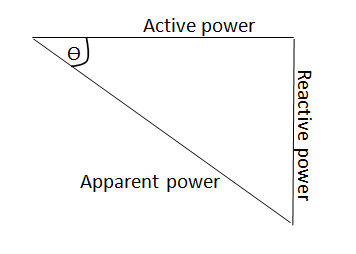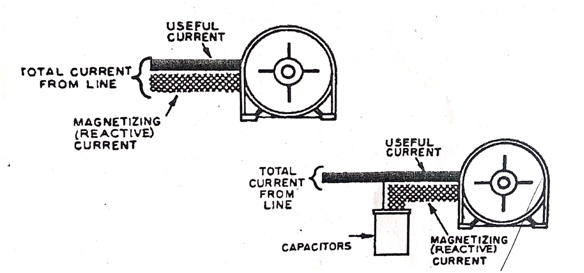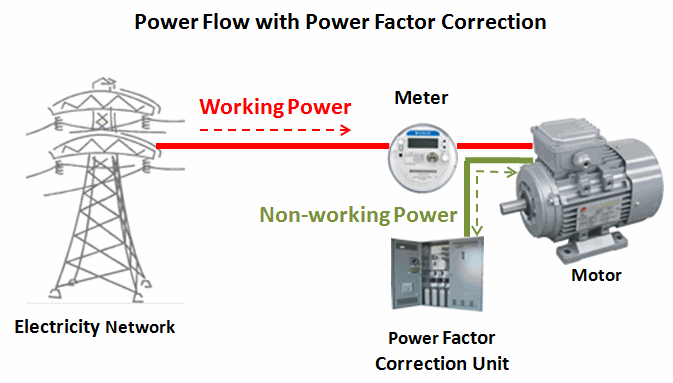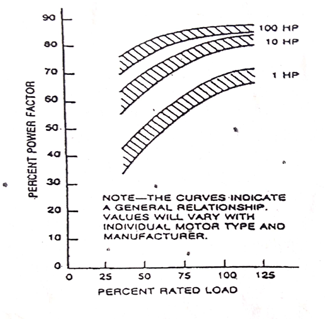85% – 90% of Electric Motors in use for commercial and industrial applications are three phase AC induction motors. The benefits are in their;
- Simplicity in design
- Efficiency
- Ruggedness
- Costs, low to operate
- Reliability
- Adaptability to variable frequency drives (VFDs)
Today, we shall review some major characteristics/parameters of Electric Motor like the Efficiency, Loading/Load Factor and Power Factor.
EFFICIENCY
Efficiency (EFF) of a motor is defined as the more electrical power a motor is able to convert to mechanical power the higher the efficiency.

Larger motors, usually have higher efficiencies than smaller motors. Since electrical energy costs money, the higher the efficiency of a motor, the lower the energy operating cost of that motor. With technological advancement and improvements aimed at cutting operating costs, the electric motors are undergoing changes ranging from new materials for the inside windings to decreased friction from well-designed ball bearings. Thus the efficiency of motors is always on the rise.
Efficiency Ratings on Motors
Very key in the economic analysis of a motor replacement, the efficiency of existing motor must be determined.
The efficiency rating on motors;
- Represents full load efficiency. The efficiency drops off as the motor is more lightly loaded.
- Manufacturers only guarantee that the motor meets nominal efficiency rating which is defined as “the average efficiency of a large population of motors of the same design.
- Motors built after 1982 have the nominal efficiency expressed as a numerical value on the nameplate.
Effect of loading on Efficiency
Efficiency decreases as the loading decreases. For large motors this drop off is minimally down to about 25% loading.


Source NEMA 1999
MOTOR LOADING DETERMINATION

Motors are rarely operated at 100% of their full load. In other words motors are loaded or have a load factor of less than 100%.

Estimating Motor load by current and voltage
Motor loading can be estimated by measuring the current and compare it to the full load name plate current. This current measurement can be deceptive as a low power factor distorting the results.
The power equation including power factor is;
W = Volts x Amps x power Factor x 1.732 (for 3-Ø)

To use this method estimate P.F to be 0.8 – 0.9 or get it from the name plate if available.

Estimating Motor Load By Slip
Motor load is closely proportional to slip. With slip you can estimate the load.
The operating speed of motors can be determined with tachometer. The number is well used in this equation.

Assuming load Factor (LP)
If measurements are not made, it is suggested that you estimate loading to be 60-70%. This is a typical motor loading in a fan or pump application but compressors load have a higher load factor.
POWER FACTOR (PF)
Is an indication of the amount of magnetizing current required by the motor.
PF Explained
A motor requires two components of current to operate. The useful current and magnetizing current. The magnetizing current generates the magnetic field that the motor needs to operate only. The useful current part contributes to mechanical work done by the motor.
The magnetizing (reactive) current, however requires line capacity. The power factor for an induction motor is usually less than one.



Power Factor Correction

Power factor correction is typically done by placing capacitors in the circuit. Capacitors store energy in an electrical field. These capacitors are sized so that they supply this energy (magnetizing current) to the motor so that the power system does not have to.
Above illustrates power factor correction. The left shows an induction without any power factor correction. The distribution lines must supply both magnetizing (reactive) and useful currents. The right shows the results of adding a capacitor near the motor. The distribution line now is required to handle only the useful current, as the magnetizing current is supplied by the capacitor.

Power factor and motor loading
This illustrates the effects of loading on the power factor of electric motors of various horsepower (HP).

At FullSpectrum, we understand that appropriate Selection, Operation, Maintenance and Proper Wiring of electric motors translate to seamless productivity and profitability i.e Motor Economics.
CONTACT US

Victor Oyedu, FNSE, FNIEEE, CPQ.
Power Quality and Energy Management Specialist.
Publisher at Afrienergyonline.com &
CEO, FullSpectrum Energy Solutions Limited, Nigeria.







